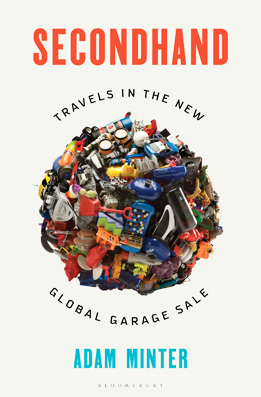|
Secondhand: Travels in the New Global Garage Sale by Adam
Minter
c.2019, Bloomsbury
$28.00 / $38.00 Canada
300 pages
By Terri Schlichenmeyer
The Truth Contributor
The paper on your living
room floor was waist-high.
That tossed-aside wrapping
– ripped off the presents in two-point-five seconds – was a
good indication of a good holiday and everyone was content.
The mess that was left, though, begged the question of where
to put all those new things. In the new book
Secondhand by Adam Minter, the answer is always a
little complicated…
No doubt about it, most of
us have a lot of stuff and our houses are full.
|
 |
|
So, says Minter, are our
garages: a 2006 study indicates that “90 percent of garage
space is now used to store stuff, not automobiles.” It’s
gotten so bad, this gathering and keeping, that businesses
have sprung up to deal with what inevitably happens when
personal belongings become an overload of unwanted items
that someone must reckon with.
In Minneapolis, Minter
found one example of the solution to the deluge.
Empty the Nest helps
seniors to downsize, hoarders to let go, and surviving adult
children to clean out parental homes. Discarded items –
which, he discovered, could be family treasures or antiques
– go to those in need, or to a thrift shop where they’re
sold to people looking for such things. Ultimately, discards
may go to landfills, but every effort is made to recycle
before that happens.
Goodwill Industries (“the
king of an American thrift trade”) runs another kind of
secondhand enterprise, relying mostly on donations from the
general public. Goodwill’s efforts to reclaim items include
boutique stores and outlets for the items least wanted; this
way, Goodwill helps “divert more than three billion
pounds of stuff from the trash heap annually.”
From Japan to India, rag
pickers to rag-cutters, Minter explains what happens to our
discards and where our excess goes when we toss it. This
underscores one important point that should give every
shopper pause: most of that which we own is worthless to
everyone but ourselves.
That’s a notion that’s
really quite sobering: all those antiques, heirlooms,
papers, and old projects you’ve been saving for the kids
someday…? Chances are, says author Adam Minter, they’ll go
to the thrift store when you’re gone, or to a business that
deals with the detritus of life. Once you’ve read
Secondhand, in other words, the presence of that fourth
spatula in your kitchen drawer seems a little wrong.
Yes, you’re probably
already familiar with thrift stores but there’s more to them
than that 99-cent vase; as Minter shows, they’re part of a
relatively-hidden network of businesses that handle what
amounts to a genuinely shocking weight of accumulation.
Those and other such companies opened their doors to him and
answered his curiosity, thereby teaching us what not to
donate, what not to purchase, why most stuff is worthless,
and why too-much-itis is a problem around the world.
If you are curious,
downsizing, or trying to be a conscientious consumer, you’ll
want this book. Having it on your shelf is perhaps the
ultimate irony, but that’s exactly where you’ll want it
because Secondhand is not something to toss aside
lightly.
|